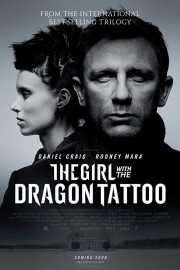The Girl With the Dragon Tattoo (’11)
If nothing else can be said about David Fincher as a director, it’s that the man has always had a way with opening title sequences. Think “Se7en.” “Fight Club.” “Panic Room.” “Zodiac.” In every single one of those films, the subversive tone of the final film is established as we watch the credits role.
In his adaptation of Stieg Larsson’s wildly popular first book in his Millennium Trilogy (named so for the independent magazine Mikael Blomkvist works for), Fincher employs the same technique. Bold, black images play out over the screen as we hear a brilliantly rage-filled cover of Led Zeppelin’s “Immigrant Song” adapted by Karen O. and the film’s composers, Trent Reznor and Atticus Ross. Watching the credits, I couldn’t help but think Fincher’s idea with them was to create a perverse twist on the famous James Bond opening sequences, which is fitting since for the role of Blomkvist, Fincher chose the current Bond, Daniel Craig.
In more ways than one, Fincher has turned “Tattoo” into a darker, bleaker Bond film, only Craig’s Blomkvist isn’t really the 007 of this tale. That would be the titular “Girl,” Lisbeth Salander, who– as anyone who watched the superb Swedish adaptations of Larsson’s novels can tell you –is one of the most fascinating fictional characters in modern movie history. A remarkable computer hacker, Lisbeth is also an outcast: decked out in Goth outfits; emotionally reserved unless she’s provoked; and sexually fluid, liable to get into bed with either men or women. She’s taken quite an interest in Blomkvist, as she’s researched him for her employer during a high-profile libel trial that has left Blomkvist financially destitute. Soon she will find herself working with the journalist on a 40-year-old mystery involving the disappearance of a young woman. Hired by an aging industrialist, Henrik Vagner (Christopher Plummer), to look into the matter, Blomkvist spends his time pouring over old photos and police reports, and interviewing members of Vagner’s corrupt family, trying to get to the bottom of it.
In both Niels Arden Oplev’s brilliant, original film last year, and Fincher’s version now, Larsson’s prose doesn’t stray far from its pulp fiction roots. This is depraved material: Antisemitism, rape, torture, brutalization (all involving women), Nazis, and damn near anything else you can imagine (or wish you couldn’t). On the surface, it’s literary trash, but Fincher and Oplev dig deeper. Both films are roughly 2 1/2 hours long, and they need to be: there’s a lot of material to cover if you’re going to get to the heart of this particular matter. Then and now, this is pulp elevated to art.
And don’t mistake Fincher’s film for a mere retread; he and screenwriter Steven Zallian (“Schindler’s List”) are too smart for that. They reshape the material, and deepen it, by delving further into the personalities, in particular, Lisbeth. Screenwriter and director come at her from a more personal level that the filmmakers of the Swedish films did, and thus, give her the spotlight she deserves. In the original film, she was a clear, supporting character; in this film, she’s front-and-center. We see her with her previous guardian (she is a ward of the state), whom has had a stroke; we feel, further, her pain when her current guardian takes sexual advantage of her; and more importantly, we sense a more personal connection with the victims her and Blomkvist are investigating. True, in the Swedish version, we get more of a look at Lisbeth’s past, but in Fincher’s movie, we see how that past has informed her worldview, and compelled her to shut down her emotions.
Fincher continues to show himself as one of the smartest, and boldest, directors in modern Hollywood. He gets sensational work from his cast, in particular Plummer, Stellan Skarsgard (as Henrik’s nephew, Martin), Craig and Rooney Mara, the young actress he cast as Lisbeth, and who matches Noomi Rapace (Lisbeth in the Swedish films) beat-for-beat in a brave and brilliant performance. (I hope we get to see her and Fincher take on the other two stories, “The Girl Who Played With Fire,” and “The Girl Who Kicked the Hornet’s Nest.”) The cinematography by Jeff Cronenweth (“The Social Network,” “Fight Club”) tells a story in images that gives further depth to the dark corners of the narrative. And once again, Reznor and Ross, who won an Oscar for their work on “The Social Network,” use sound design and music to enhance the sense of unease as Blomkvist and Lisbeth go further down the rabbit hole. I don’t know if Oscar will be as kind to Fincher and his collaborators this year (this is pretty straightforward crime fiction, after all), but the director of “Se7en” and “Zodiac” remains a great purveyor of disturbing tales of the criminal mind. I can’t wait to see what he has up his sleeve with the rest of Larsson’s novels. Hopefully, we’ll get to find out.










